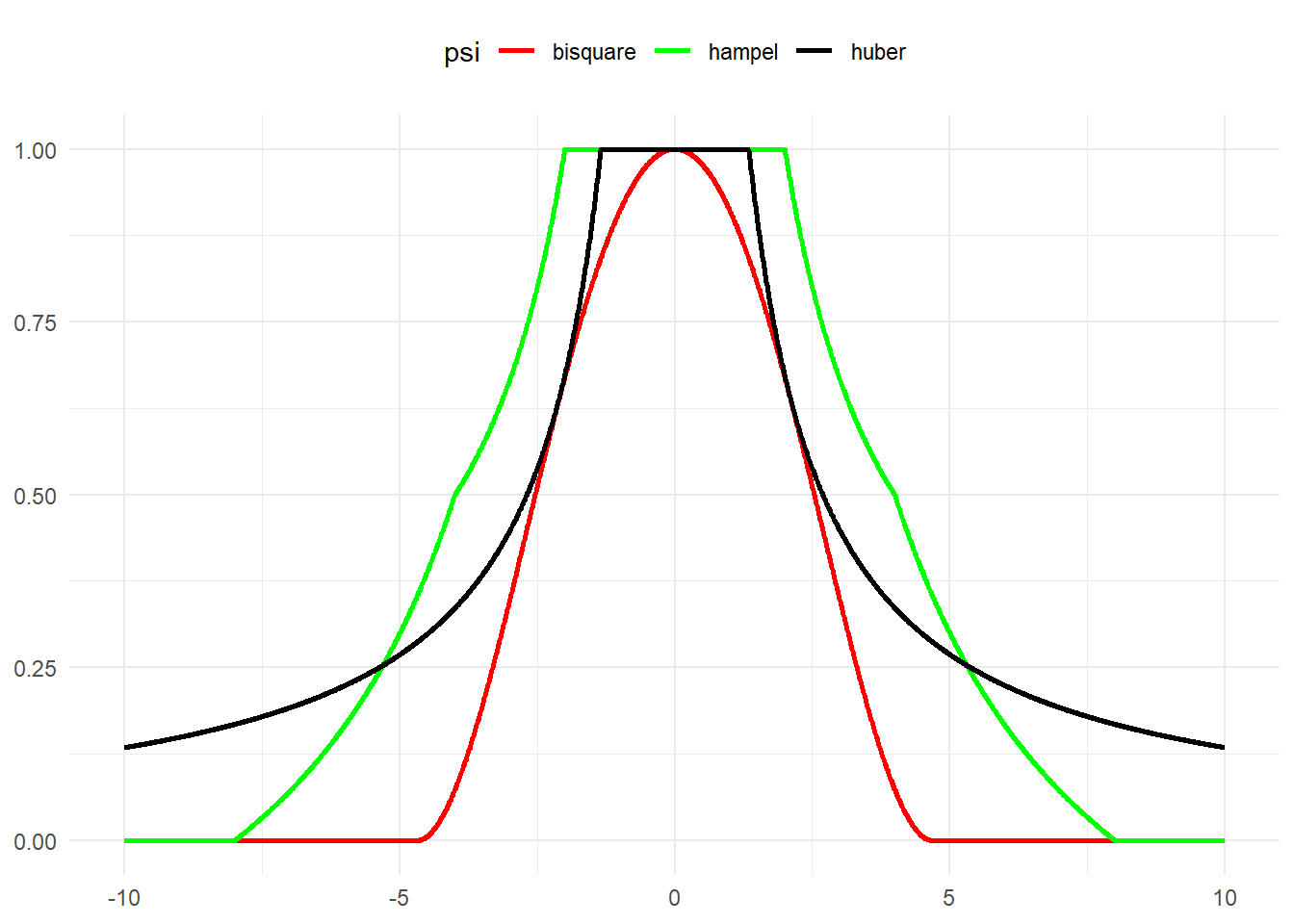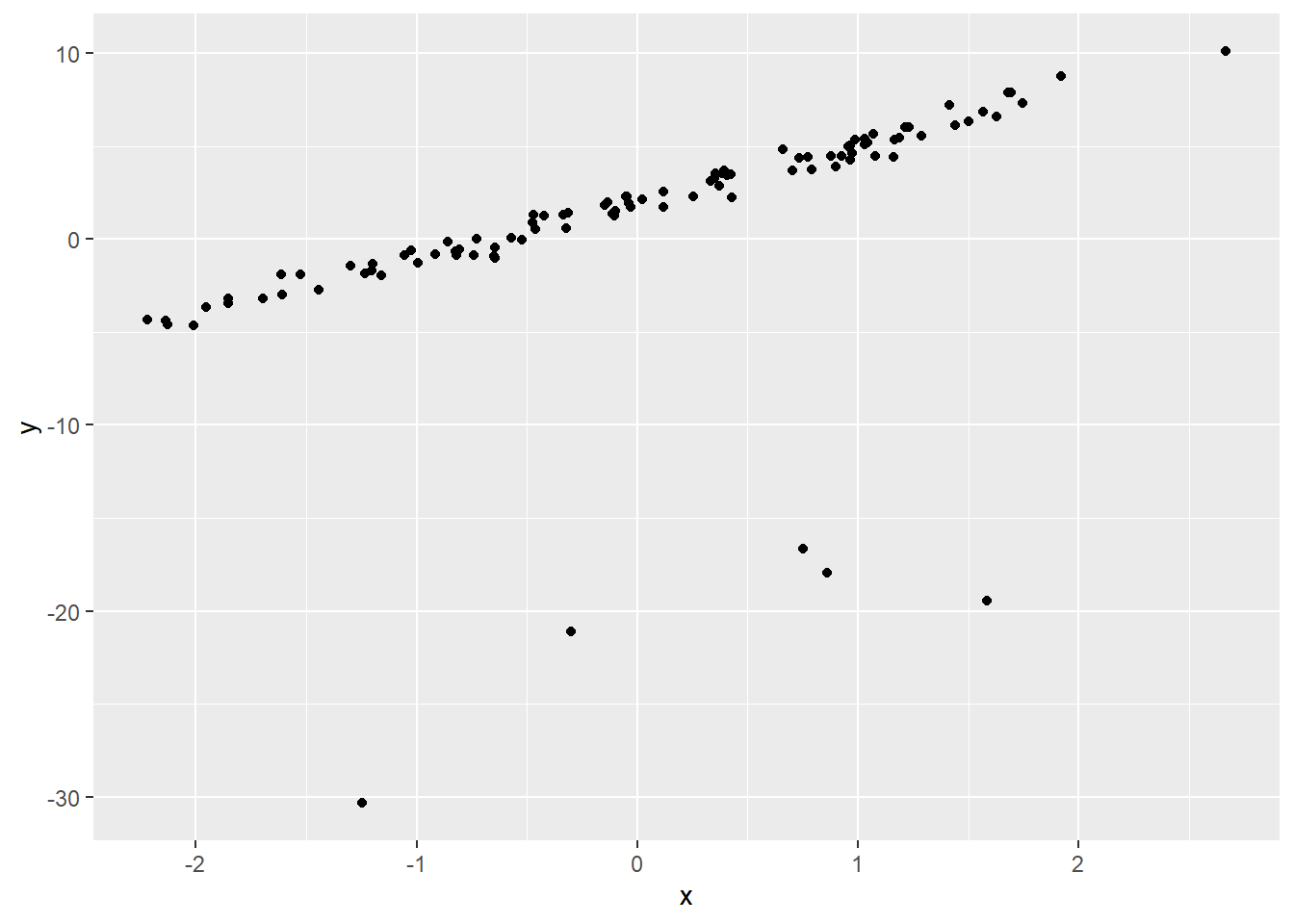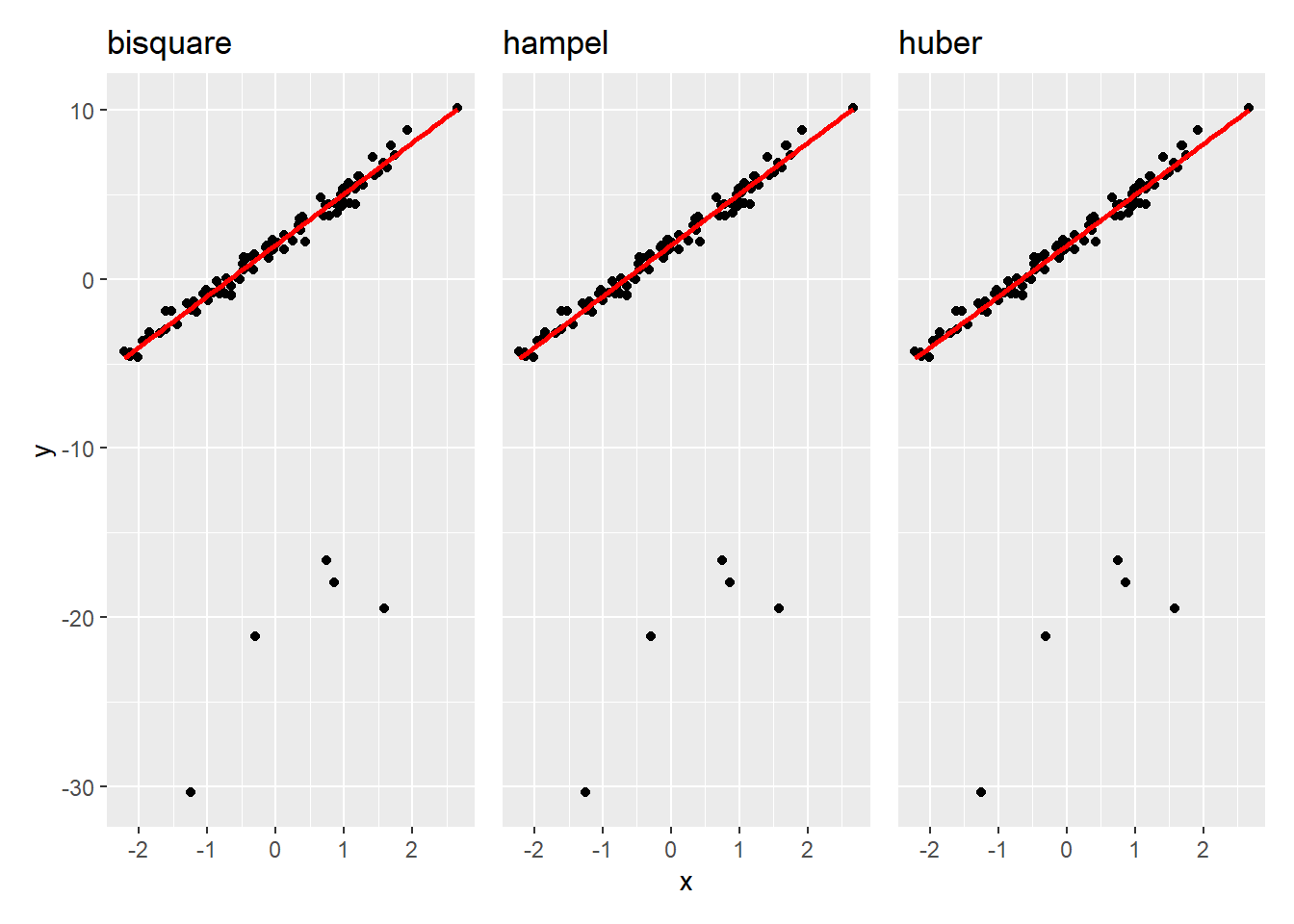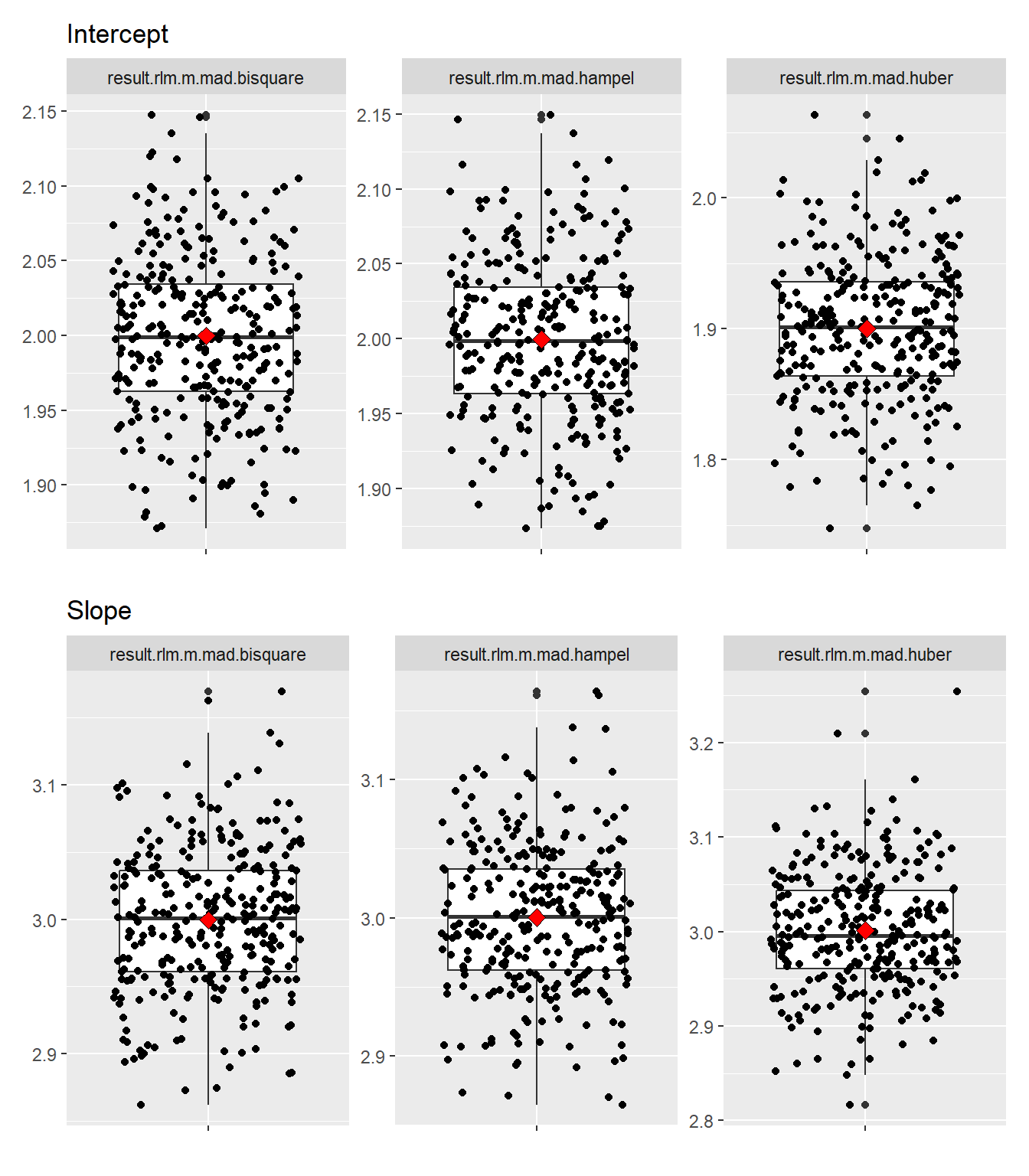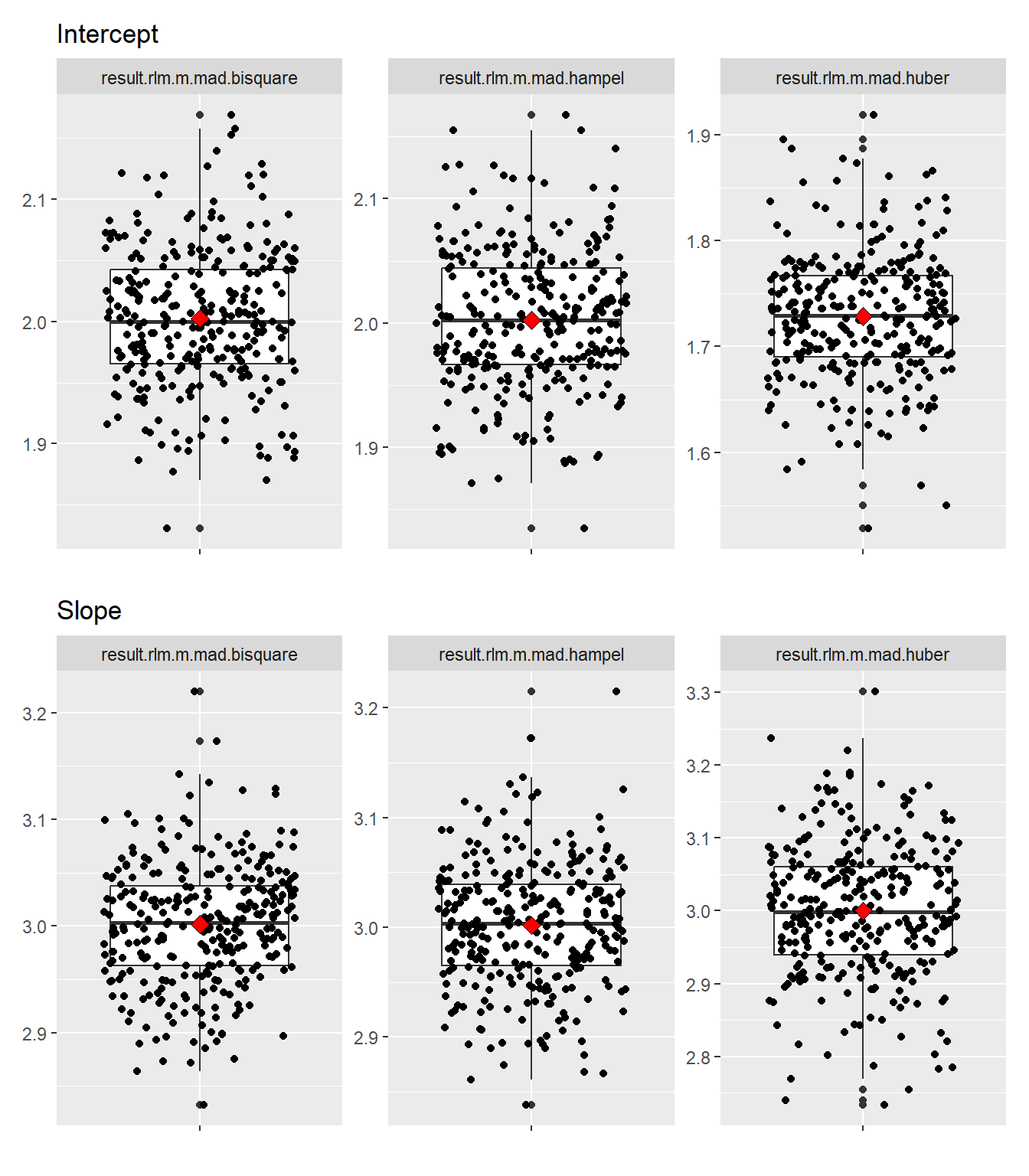ロバスト線形回帰を扱うRの関数 rlm {MASS} について、引数 method を M推定 とした場合における、引数 psi(影響関数) の3つの選択肢、huber、hampel および bisquare それぞれの結果をシミュレーションで比較します。
本ポストは以下の資料を参照引用しています。
- https://www.stat.go.jp/training/2kenkyu/ihou/76/pdf/2-2-767.pdf
- https://www.st.nanzan-u.ac.jp/info/gr-thesis/ms/2004/kimura/01mm029.pdf
- https://stat.ethz.ch/R-manual/R-devel/library/MASS/html/lqs.html
前述の psi はロバスト線形回帰における 影響関数 を指定する引数です。
library(ggplot2)
library(dplyr)
library(MASS)
u <- seq(-10, 10, by = 0.01)
bisquare <- psi.bisquare(u)
huber <- psi.huber(u)
hampel <- psi.hampel(u)
data.frame(u, bisquare, huber, hampel) %>%
tidyr::gather("psi", , colnames(.)[-1]) %>%
ggplot(mapping = aes(x = u, y = value, color = psi)) +
geom_line(linewidth = 1) +
theme_minimal() +
theme(axis.title = element_blank(), legend.position = "top") +
scale_color_manual(values = c("red", "green", "black"))始めに外れ値のあるサンプルデータを生成する関数を作成します。
なお、外れ値は全て「意図的に大きな外れ」とし、かつ回帰直線を「下方向に引っ張る」値とします。
fun_sampledata <- function(seed, n, nout) {
set.seed(seed)
# 真のモデル: y = 2 + 3x + ε
x <- rnorm(n)
y_true <- 2 + 3 * x
y <- y_true + rnorm(n, sd = 0.5)
# 外れ値追加
id_out <- sample(x = seq(n), size = nout, replace = F)
y[id_out] <- y_true[id_out] + runif(n = nout, min = -30, max = -20)
data <- data.frame(x = x, y = y)
return(data)
}サンプルサイズは100点。うち5点(全体の5%)を外れ値としたサンプルです。
seed <- 20250328
n <- 100
nout <- 5 # 外れ値数
data <- fun_sampledata(seed = seed, n = n, nout = nout)
glimpse(data)Rows: 100
Columns: 2
$ x <dbl> 0.02159254, 0.96746160, 1.62807097, 0.97288576, -0.13582887, 1.16101…
$ y <dbl> 2.1168963, 5.0291520, 6.5931878, 4.6417599, 1.9604232, 4.4299156, -3…外れ度合い をチャートで確認します。
作成したサンプルデータについて、それぞれの影響関数を選択した場合の結果をチャートで比較します。
library(patchwork)
g_bisquare <- g0 + geom_smooth(method = "rlm", se = F, color = "red", method.args = list(method = "M", psi = psi.bisquare, scale.est = "MAD")) + labs(title = "bisquare")
g_hampel <- g0 + geom_smooth(method = "rlm", se = F, color = "red", method.args = list(method = "M", psi = psi.hampel, scale.est = "MAD")) + labs(title = "hampel")
g_huber <- g0 + geom_smooth(method = "rlm", se = F, color = "red", method.args = list(method = "M", psi = psi.huber, scale.est = "MAD")) + labs(title = "huber")
g_bisquare + g_hampel + g_huber + plot_layout(axes = "collect")目視では差は殆ど確認できませんが、
list(bisquare = rlm(data$y ~ data$x, method = "M", psi = psi.bisquare, scale.est = "MAD"), hampel = rlm(data$y ~ data$x, method = "M", psi = psi.hampel, scale.est = "MAD"), huber = rlm(data$y ~ data$x, method = "M", psi = psi.huber, scale.est = "MAD"))$bisquare
Call:
rlm(formula = data$y ~ data$x, psi = psi.bisquare, scale.est = "MAD",
method = "M")
Converged in 4 iterations
Coefficients:
(Intercept) data$x
2.01346 3.02080
Degrees of freedom: 100 total; 98 residual
Scale estimate: 0.498
$hampel
Call:
rlm(formula = data$y ~ data$x, psi = psi.hampel, scale.est = "MAD",
method = "M")
Converged in 3 iterations
Coefficients:
(Intercept) data$x
2.007942 3.023237
Degrees of freedom: 100 total; 98 residual
Scale estimate: 0.502
$huber
Call:
rlm(formula = data$y ~ data$x, psi = psi.huber, scale.est = "MAD",
method = "M")
Converged in 5 iterations
Coefficients:
(Intercept) data$x
1.967675 3.006463
Degrees of freedom: 100 total; 98 residual
Scale estimate: 0.543 実際には 切片 と 傾き に差が生じています
それでは300試行のシミュレーションにより、3つの影響関数それぞれのロバスト線形回帰の係数(切片 と 傾き)を比較します。
fun_simulation <- function(iter, n, nout) {
formulatxt <- sampledf$y~sampledf$x
method <- "M"
maxit <- 100
scale.est <- "MAD"
for (iii in seq(iter)) {
sampledf <- fun_sampledata(seed = iii, n = n, nout = nout)
# 係数の抽出
result.rlm.m.mad.bisquare <-
rlm(formulatxt,
scale.est = scale.est,
method = method,
psi = psi.bisquare,
maxit = maxit
)$coef
result.rlm.m.mad.hampel <-
rlm(formulatxt,
scale.est = scale.est,
method = method,
psi = psi.hampel,
maxit = maxit
)$coef
result.rlm.m.mad.huber <-
rlm(formulatxt,
scale.est = scale.est,
method = method,
psi = psi.huber,
maxit = maxit
)$coef
resultdf0 <- rbind(result.rlm.m.mad.bisquare, result.rlm.m.mad.hampel, result.rlm.m.mad.huber) %>%
t() %>%
data.frame(check.names = F) %>%
{
.$itr <- iii
.
}
if (iii == 1) {
resultdf_coef <- resultdf0
} else {
resultdf_coef <- rbind(resultdf_coef, resultdf0)
}
}
# 切片
tidydf <- resultdf_coef %>%
row.names() %>%
grep("Intercept", .) %>%
resultdf_coef[., ] %>%
{
tidyr::gather(., , , colnames(.)[-4])
}
g_coef_intercept <- tidydf %>% ggplot(mapping = aes(x = "", y = value)) +
geom_boxplot() +
geom_jitter() +
facet_wrap(. ~ key, scales = "free_y") +
theme(axis.title = element_blank()) +
labs(title = "Intercept") +
stat_summary(fun = "mean", geom = "point", shape = 23, size = 3, fill = "red")
# https://r-graphics.org/RECIPE-DISTRIBUTION-BOXPLOT-MEAN.html
# 傾き
tidydf <- resultdf_coef %>%
row.names() %>%
grep("sampledf", .) %>%
resultdf_coef[., ] %>%
{
tidyr::gather(., , , colnames(.)[-4])
}
g_coef_slope <- tidydf %>% ggplot(mapping = aes(x = "", y = value)) +
geom_boxplot() +
geom_jitter() +
facet_wrap(. ~ key, scales = "free_y") +
theme(axis.title = element_blank()) +
labs(title = "Slope") +
stat_summary(fun = "mean", geom = "point", shape = 23, size = 3, fill = "red")
g_coef_intercept + g_coef_slope + plot_layout(nrow = 2)
}始めに外れ値を全体の10%とした場合を比較します。
「遠くの外れ値」にも影響を残す huber が他の2つよりも切片が下に引き摺られている事、切片、傾き ともに huber は他の2つよりも分散が大きい事を確認できます。
続いて外れ値を全体の20%にした場合です。
huber では、外れ値を10%とした場合よりもさらに 切片 が下に引き摺られている事、他の2つの影響関数よりも 切片、傾き ともに分散が大きいことを確認できます。
以上です。

